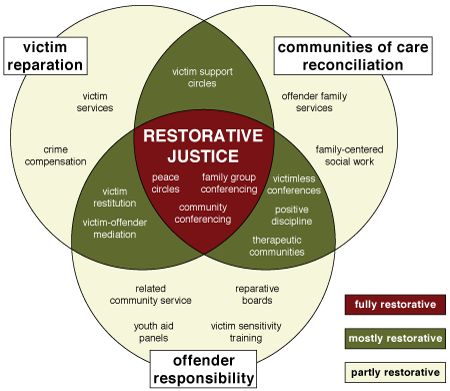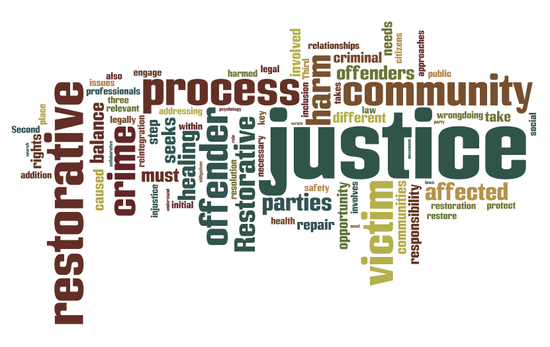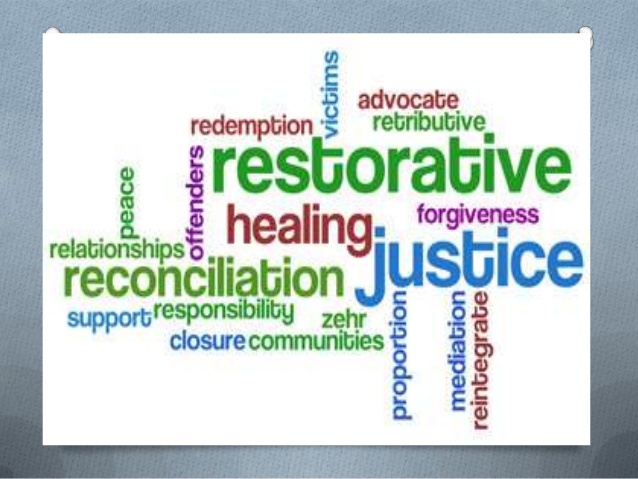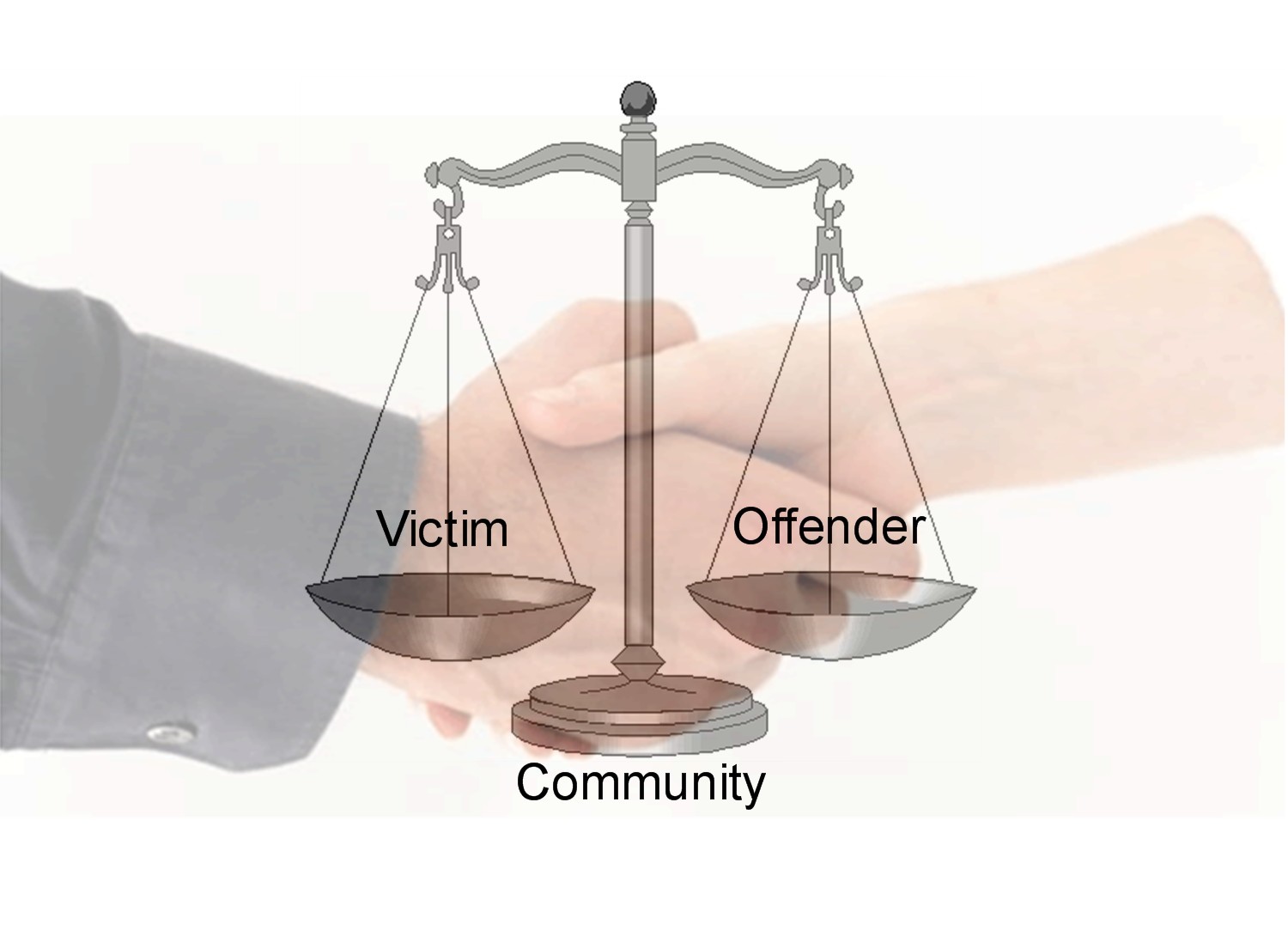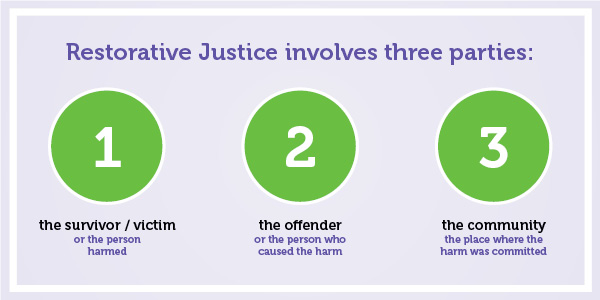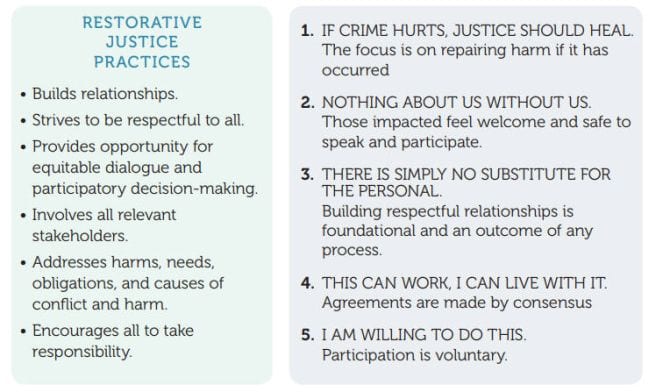
WHAT IS RESTORATIVE JUSTICE AND WHEN DOES IT COME INTO PLAY?
"Restorative justice is a process to involve, to the extent possible, those who have a stake in an offense and to collectively identify and address harms, needs and obligations, in order to heal and put things right as possible." – Howard Zehr, PhD, The Little Book of Restorative Justice, 2002
In a general sense, restorative justice focuses on building and strengthening relationships in a community. Fundamentally, it's about how people create communities that are connected, where people are open with one another, where there's a sense of trust and relationship. It's a way of doing justice that focuses on the relationships of a situation. It leads to healthier, more effective communities.
The restorative piece comes into play when harm is done by or to a community member. How do we bring people together to repair that harm in ways that are safe, and enable people to move on? The focus is on building on strong values and strengthening relationships at all levels. It's not soft or easy. It holds people accountable and (hopefully) leads in the end to an outcome that's bigger than just retribution or punishment.
As churches, we often don't focus enough on fostering honest community relationships. We need to understand the ways that our actions affect one another, but many ministries do not know how to encourage that understanding. It just happens, or it doesn't. Leadership needs to intentionally foster dialogue and help people build relationships. The relationship level is the place to deal with conflict and harm in churches. We need to invite people back into a notion of the community as a circle.
“Restorative justice is important for the families of both victims and offenders as issues between parties can go unresolved for years, leading to violence and retribution,” By using a community-mediated solution, family members are able to start the process of reconciliation and compensation.
Churches and law enforcement agencies are working together with communities to promote restorative justice. Restorative justice responds to criminal behavior by balancing the needs of the community, the victims and the offenders. Communities are given training to develop their own restorative justice capacity, with offenders encouraged to take responsibility for their actions and make amends.
Justice can only prevail if community leaders have access to law and justice information and are able to work in partnership with churches and key law enforcement agencies to address the social issues that lead to lawlessness,”
Restorative justice is both ancient and new. It was practiced in communities around the world before laws were written down. Yet, communities like ours are still learning about it (or maybe relearning it).
To get started, here’s a basic definition:
There are three basic principles that all restorative justice programs subscribe to:
Crime is a violation of people and relationships. Yes, a law may have been broken, but the harm is primarily against people, not an abstract law or other state entity. Crime creates harms, needs, and obligations. If crime upsets the balance and results in actual harms and needs, then who should be primarily obliged to restore that balance?
Those most affected should be meaningfully included and empowered. If John broke into Ms. Jones’s home, we should ask Ms. Jones what she wants and needs from the process.
What is Restorative Justice?
Restorative justice is a response to crime and violence that shifts the focus from punishment to "responsibility, rehabilitation and restoration." It holds offenders accountable even as it opens paths to healing, especially with victims. And it addresses the needs of everyone impacted by crime: victims, offenders, families, communities, and those working in the criminal justice system.
For Survivors:
It is a tremendous honor and obligation to bring people into right relationship with others, and to heal the wounded in our midst. Restorative justice empowers survivors of crime and their families by:
--Providing for physical and emotional care first
--Ensuring obligations created by the offender are met
--Requiring community services that encourage a healthy return to life
For Offenders & Their Families:
Restorative Justice extends to those who commit the crime. Those rightfully convicted must face the consequences of their actions, but that shouldn’t mean being deprived of their dignity. Basic human rights must extend to all people. For offenders and their families, restorative justice means:
--Holding people accountable for their actions.
--Protecting and upholding families of the incarcerated, especially the children.
--Ensuring humane treatment and sentencing that rehabilitates.
--Attending to the spiritual formation of inmates and providing opportunities for worship.
--Preparing the formerly incarcerated for rejoining both family and the community.
Restorative justice opens the opportunities for personal and community transformation. This transformation cannot be mapped, planned, or put into a program or structure. Nevertheless, it can be encouraged and nurtured.
For The Community:
In recent years, the concept of restorative justice has taken root in this region. Victims are asking to be better served in the wake of crime. Offenders are looking for constructive ways to make amends. Communities are asking for innovative approaches to crime and wrongdoing.Crime tears at the fabric of all communities, particularly neighborhoods that are struggling economically. Vulnerable areas can become hopeless places.
Restorative justice activities bring people together and empower them to work for safety, services, and programs that heal. Restorative justice for communities includes:
--Working with law enforcement officials to reduce violence
--Providing alternatives for at-risk youth that make gangs less attractive
--Organizing people to improve public services and change laws
For The Church:
Repeatedly, Jesus confronted the human desire for revenge and punishment, turning his listeners instead in the direction of genuine correction, mercy, and a new life.
The churches active in the Restorative Justice have agreed to pursue this direction.
There are many ways Christians can pursue restorative justice, from working to help victims of crimes restore their lives to visiting people in prison and helping them build new lives, and much more.
In recent years several approaches have been given the greatest focus by Churches – the struggle to end the use of the death penalty, and efforts to invest in new lives for people who have completed their prison sentences so that they will not return to jail.
